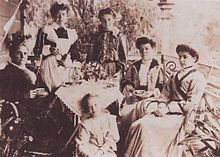 Australian women having tea on a verandah in 1910 | |
| General Statistics | |
|---|---|
| Maternal mortality (per 100,000) | 6 (2015) |
| Women in parliament | 30.5% (2015) |
| Women over 25 with secondary education | 91.4% (2015) |
| Women in labour force | 58.6% (2015) |
| Gender Inequality Index[1] | |
| Value | 0.073 (2021) |
| Rank | 19th out of 191 |
| Global Gender Gap Index[2] | |
| Value | 0.738 (2022) |
| Rank | 43rd out of 146 |
| Part of a series on |
| Women in society |
|---|
 |
Women in Australia refers to women's demographic and cultural presence in Australia. Australian women have contributed greatly to the country's development, in many areas. Historically, a masculine bias has dominated Australian culture.[3] Since 1984, the Sex Discrimination Act 1984 (Cth) has prohibited sex discrimination throughout Australia in a range of areas of public life, including work, accommodation, education, the provision of goods, facilities and services, the activities of clubs and the administration of Commonwealth laws and programs, though some residual inequalities still persist.
In 2017, Australia was ranked the world's safest country for women by the New World Wealth research group.[4]
- ^ "Human Development Report 2021/2022" (PDF). HUMAN DEVELOPMENT REPORTS. Retrieved 6 October 2022.
- ^ "Global Gender Gap Report 2022" (PDF). World Economic Forum. Retrieved 15 February 2023.
- ^ Schaffer, Kay (1988). Women and the Bush: Forces of Desire in the Australian Cultural Tradition. Cambridge University Press. pp. 5–7. ISBN 978-0521368162. Retrieved 23 August 2016.
- ^ Australia, Chris Pash, Business Insider. "The 10 safest countries in the world for women". Business Insider. Retrieved 2019-03-23.
{{cite web}}:|first=has generic name (help)CS1 maint: multiple names: authors list (link)